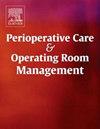Survival status and predictors of mortality among emergency laparotomy patients in a selected governmental hospital in Addis Ababa, Ethiopia; retrospective cohort study (2020 and 2023)
IF 1
Q2 Nursing
Perioperative Care and Operating Room Management
Pub Date : 2025-06-24
DOI:10.1016/j.pcorm.2025.100517
引用次数: 0
Abstract
Background
Emergency laparotomy is one of the highest-risk surgical procedures globally, associated with significant morbidity and mortality. The burden is especially severe in low- and middle-income countries, such as Ethiopia, where limited healthcare resources, delayed care, and inadequate postoperative management significantly contribute to these outcomes. Despite global efforts to reduce surgical mortality, a significant knowledge gap persists regarding the specific factors driving high mortality rates in these settings. This study is crucial for improving patient outcomes by identifying factors that contribute to high mortality rates and developing effective mitigation strategies.
Objective
To assess survival status and predictors of mortality among emergency laparotomy patients in selected governmental hospital in Addis Ababa, Ethiopia. from January 1, 2020, to January 1, 2023.
Methods
A retrospective cohort study was conducted in four government hospitals in Addis Ababa, Ethiopia between 2020 and 2023, focusing on emergency laparotomy patients. The study analyzed 374 patient charts using EpiData version 4.6.0.2 and STATA version 17. A Cox proportional hazards regression model was used to correlate independent variables with dependent variables. Bivariate and multiple Cox regression analyses were performed to identify predictors. Kaplan-Meier graphs were used for estimation. The hazard ratio hazard ratio and the 95 % confidence interval were calculated, with factors showing a p-value of <0.05 being strongly correlated with patient mortality.
Results
A total of 374 patients were retrospectively followed from a sample of 379, as data for 5 patients were excluded due to not meeting the criteria because of incomplete information. the median follow-up time was 19 days. The overall mortality rate for patients who underwent emergency laparotomy was 10.43 %. Factors such as pre-existing disease (AHR = 5.43, 95 % CI 1.56, 18.97), preoperative sepsis (AHR = 1.2, 95 % CI 1.03, 3.47), intraoperative use of vasopressors (AHR = 8.49, 95 % CI 1.69, 42.65), and postoperative complications (AHR = 3.73, 95 % CI 1.02, 13.65) were significantly associated with mortality in these patients.
Conclusions
The overall mortality rate among patients who underwent emergency laparotomy was high compared to previous studies. Pre-existing disease, preoperative sepsis, intraoperative use of vasopressors, and postoperative complications were significant factors. Therefore, preoperative optimization and the development of standard operating procedures are essential.
埃塞俄比亚亚的斯亚贝巴某政府医院急诊剖腹手术患者的生存状况和死亡率预测因素回顾性队列研究(2020年和2023年)
背景急诊剖腹手术是全球风险最高的外科手术之一,与显著的发病率和死亡率相关。在埃塞俄比亚等低收入和中等收入国家,这种负担尤其严重,在这些国家,有限的医疗资源、延迟的护理和不充分的术后管理是导致这些结果的主要原因。尽管全球都在努力降低手术死亡率,但在这些环境中导致高死亡率的具体因素方面,仍然存在重大的知识差距。这项研究通过确定导致高死亡率的因素和制定有效的缓解策略,对改善患者预后至关重要。目的评价埃塞俄比亚首都亚的斯亚贝巴某政府医院急诊剖腹手术患者的生存状况及死亡率预测因素。从2020年1月1日到2023年1月1日。方法对埃塞俄比亚首都亚的斯亚贝巴4家政府医院于2020 - 2023年进行回顾性队列研究,研究对象为急诊剖腹手术患者。该研究使用EpiData版本4.6.0.2和STATA版本17分析了374例患者的图表。采用Cox比例风险回归模型对自变量与因变量进行相关性分析。采用双变量和多重Cox回归分析来确定预测因子。Kaplan-Meier图用于估计。计算风险比风险比和95%置信区间,p值为0.05的因素与患者死亡率密切相关。结果回顾性随访379例患者共374例,其中5例因资料不全不符合标准而被排除。中位随访时间为19天。急诊剖腹手术患者的总死亡率为10.43%。既往疾病(AHR = 5.43, 95% CI 1.56, 18.97)、术前脓毒症(AHR = 1.2, 95% CI 1.03, 3.47)、术中使用血管加压剂(AHR = 8.49, 95% CI 1.69, 42.65)和术后并发症(AHR = 3.73, 95% CI 1.02, 13.65)等因素与这些患者的死亡率显著相关。结论急诊剖腹手术患者的总死亡率高于以往的研究。既往疾病、术前败血症、术中使用血管加压剂和术后并发症是重要因素。因此,术前优化和标准操作程序的制定是至关重要的。
本文章由计算机程序翻译,如有差异,请以英文原文为准。
求助全文
约1分钟内获得全文
求助全文
来源期刊

Perioperative Care and Operating Room Management
Nursing-Medical and Surgical Nursing
CiteScore
1.30
自引率
0.00%
发文量
52
审稿时长
56 days
期刊介绍:
The objective of this new online journal is to serve as a multidisciplinary, peer-reviewed source of information related to the administrative, economic, operational, safety, and quality aspects of the ambulatory and in-patient operating room and interventional procedural processes. The journal will provide high-quality information and research findings on operational and system-based approaches to ensure safe, coordinated, and high-value periprocedural care. With the current focus on value in health care it is essential that there is a venue for researchers to publish articles on quality improvement process initiatives, process flow modeling, information management, efficient design, cost improvement, use of novel technologies, and management.
 求助内容:
求助内容: 应助结果提醒方式:
应助结果提醒方式:


